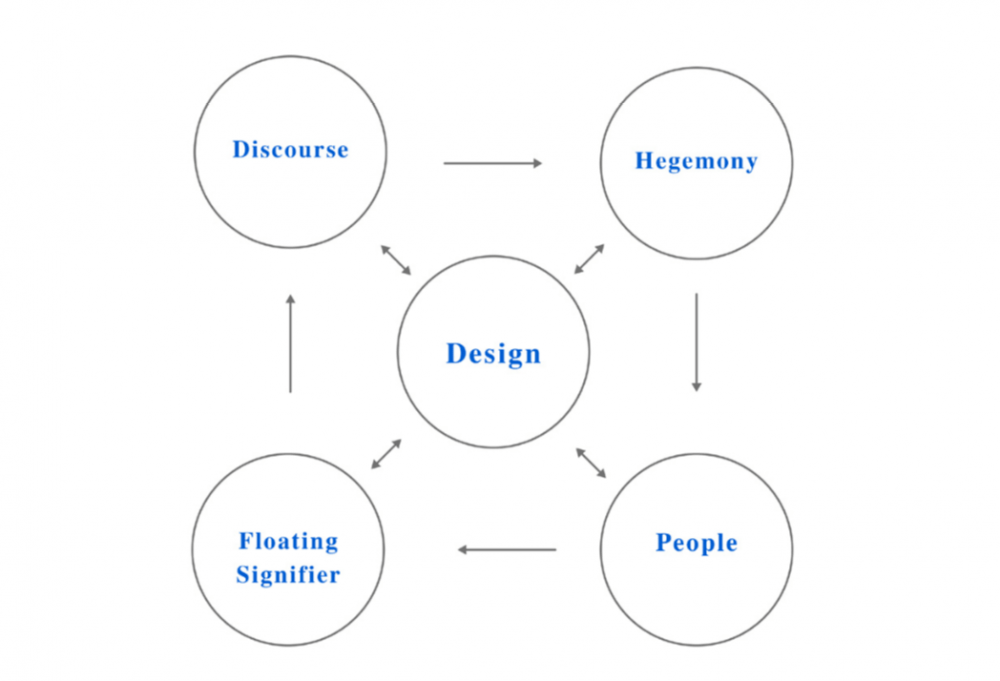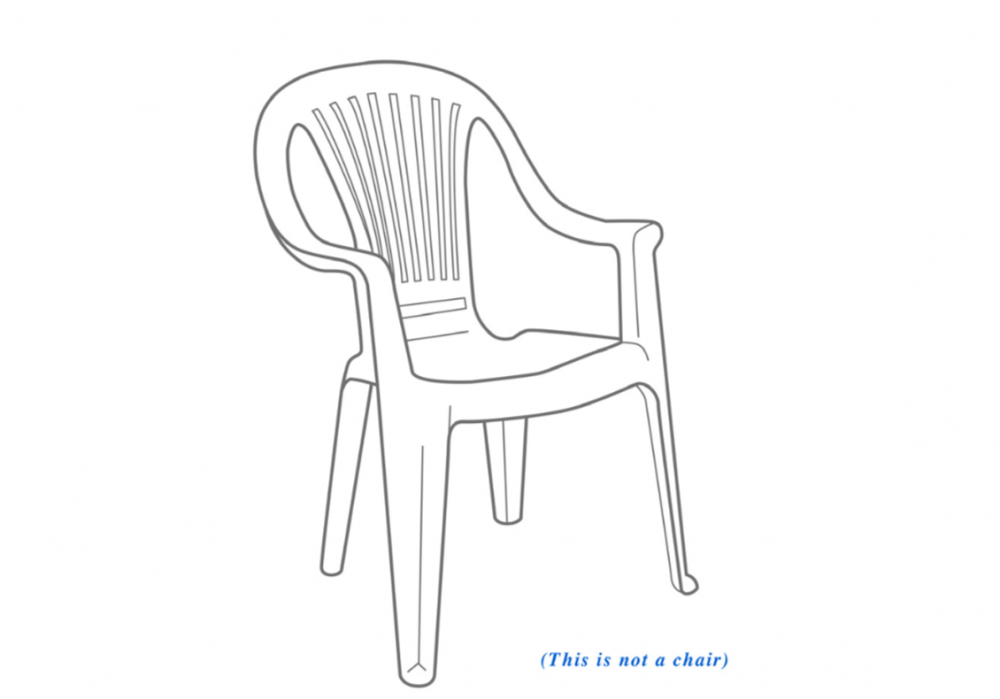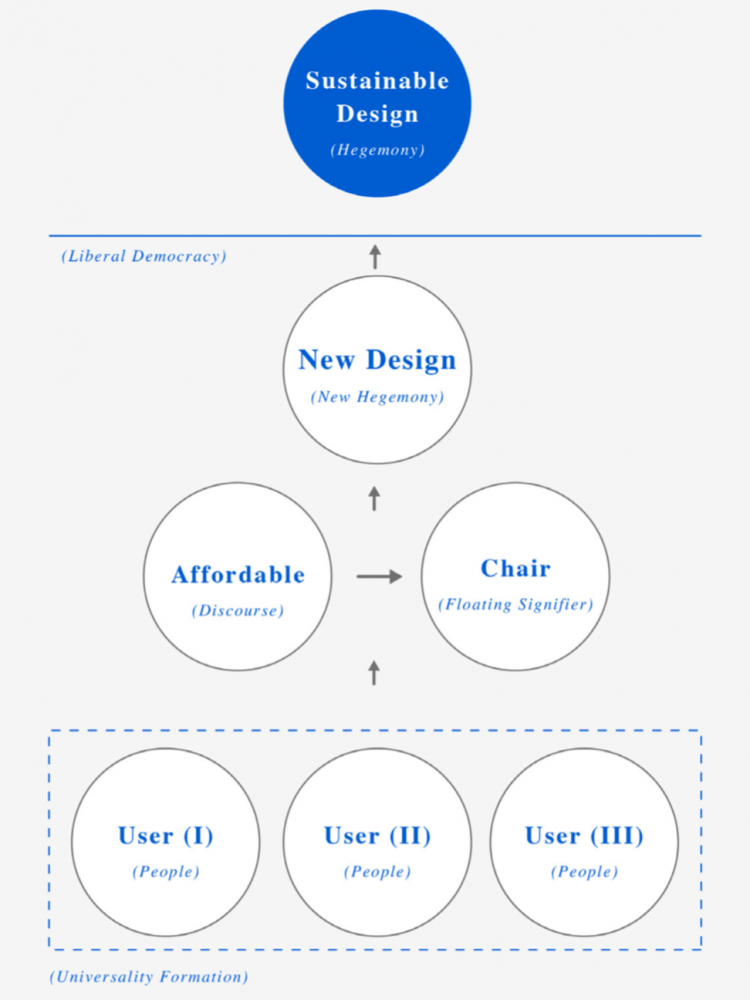Populism, Design, and Ideology
Oliver Arellano and Ever Osorio
In the last two decades, studies around design as a practice have flourished, along with the re-launching of several museums and cultural spaces dedicated exclusively to design. Design, defined both by its practice and objects, has claimed a prominent role in affecting global modernity. While many investigations have been dedicated to the centrality of design in the history of visual and material cultures, and its flourishing through the Industrial Revolution, other efforts have been directed toward apprehending the political dimension of design. Through this perspective, design as a practice occupies a position of power because it determines everything from urban development principles to medical services to the use and creation of visual languages, identities, branding, and marketing. As a practice, design is political in two ways. On the one hand, it is political because it reproduces already established, dominant relations of power and governmentalities; on the other, because it has the capacity of resisting and countering the inertia of these power relations.
This paper is dedicated to exploring the political dimensions of design as a practice beyond “political design.” By political design, we refer to design projects that particularly deal with political issues such as voting or public participation. This is not a negation of liberal democracies as part of the political landscape/space in which design takes place, but rather an acknowledgment of the relations of power that reconfigure during design processes found in research and development, visual design, marketing, and product development departments of private corporations and public organizations. Under this perspective, design is not a manifestation of pure creativity crystallized in extraordinary products that eventually make it to the marketplace of a liberal economy, but it is a historically contingent practice that takes place under a liberal democracy.
The fact that we live in an artificial world means that designers are making millions of decisions, based on universalist assumptions, in order to design cultural objects in this contemporary historical moment. This critical positionality of the designer makes him/her an unseen political actor in formal politics.1 Furthermore, the particular location of design and designers in this invisible spot makes the development of a technology, or a method of design criticism that is distinct from art or literary criticism, necessary. If the position of design in society is ubiquitous and central to the way we live—affecting the way cities are designed as well as the reason why we sit on chairs—then it would be appropriate to draw methods from other disciplines in order to elaborate what Marx called “a ruthless criticism of the existing order.”2
Drawing from the theoretical interventions of design theorists Carl DiSalvo and Tony Fry, we propose the use of radical democracy3—namely, the logic of populism and agonistic pluralism—in the critical examination of the ideological dimension of contemporary design practices, beyond those explicitly concerned with politics. Populism, here, does not refer to an ideology or to a form of dictatorial politics, but to a rationality intrinsic to democratic societies, at least in the formal sense. Therefore, the populist logic operates in the domain of ideology through the production and reproduction of material and semiotic cultures, which abound not only in formal politics, but in all processes that involve cultural production.
Design, Politics, and Populism
In his influential book Design and Politics, theorist Tony Fry makes a critique of liberal democracy as a globally adopted political system based on three insights. The first is that democracy is not sufficiently criticized; the second is that to criticize democracy does not imply that democracy “can be reduced to a simple singularity and that there are not other modes of politics that equally demand critical scrutiny.”4 The third and last point is that “democracy as an operative political system must not be viewed as the most advanced possible form of political practice.”5 He continues by arguing that the current form of democratic politics is not the only possible one, since liberal democracy is not the same as popular democratic practice. For Fry, democracy as it is practiced today—as a liberal democracy—limits the popular democratic practice of institutionalized politics.6 It is within this understanding of the political present that Fry identifies the need for a different political praxis capable of transforming the current order of things. This change cannot happen through discursive formations, but rather must happen through a “dynamic transformative agency” in which he locates design.7
Fry departs from a materialist and phenomenological critique of the historical present in which he acknowledges the artificiality of the world. By stating that “we live in a world where everything is made and can be made,”8 he is arguing for the ubiquitous presence of design practice. As a set of materialized practices crystallized in objects, cities, political processes, services, and visual identities, design is a space in which transformative agency can unveil and decentralize dominant discursive formations that are institutionalized under liberal democracy as a government regime. In Fry’s words,
Artifice does not arrive without design and design and artifice combine to render ‘the world of our dwelling’ political, and thus contestable. In any real sense, as said, politics does not grasp this. In fact institutional politics actually lacks of the enormous ontological shifts taking place on the very ground of ‘human being’ via designed hegemonic technology and the world made unsustainable.9
In this respect, we identify that this position is invisible even when the material fabric of the world is made by and through designers. Fry’s “silent structuring agency” of design is in opposition to explicit symbols and discourses.10 What Fry overall suggests is the necessity of making design a proactive and open political practice.
In the same vein, Carl DiSalvo makes a productive critique of liberal democracy by identifying the differences between the concepts of the political and of politics, not only through a theoretical revision of the work of Ernesto Laclau, Chantal Mouffe, John Rawls, and Jürgen Habermas, but also by examining two design exercises that directly deal with politics and democracy.11 DiSalvo discovers that political design projects like AIGA’s “Design for Democracy” reinforce liberal democratic governmentalities that foreclose the realm of the political to constrained institutional practices—such as voting—without expanding the understanding of the political to less explored areas. In contrast, through an analysis of agonistic pluralism, DiSalvo identifies spaces and places of political contestation present in design practices that challenge institutionalized politics. The author’s final claim is for the use of radical theories of democracy—like agonistic pluralism—in exercises of political design that expand the realm of the political beyond liberal democratic politics.12
Fry’s project offers a philosophical reflection on the powerful role of design as a political agent capable of transforming the world, DiSalvo focuses on the concrete uses of theories of radical democracy in the development of political design projects. Our objective is to cross-pollinate Fry’s materialist philosophical enquiry and DiSalvo’s praxis to expand the uses of radical democratic theory beyond explicitly political design projects. We propose to use the method of radical democracy, in particular Laclau’s model of populist logic, to make visible the discourses and hegemonic formations operating in design practices in private companies, NGOs, and governments. We consider that this theoretical approach not only expands the realm of the political beyond liberal institutionalized politics but also allows for critical examination and social accountability of design practices with direct impact to the public interests that traditionally go unnoticed by political actors.
In an effort parallel to that of DiSalvo, we propose the use of the definition of populism elaborated by Laclau and Mouffe for a critical examination of design. Our interest lies in the particular method that the schema of populism provides (as a political logic and analytical theory). Laclau describes populism as a phenomenon that occurs in the formation of unities of popular subjects and/or groups where they overcome a dominant hegemonic formation.13 Through this movement, the emerging group becomes the new hegemonic group. This logic needs to be performed as a temporal formation in which political difference is represented either as a group identity or a political party; otherwise, any new hegemony can exist, but it would not affect the political relation of power.
A commonly observed dilemma of this theory is that Laclau, by stating that populism is a natural condition for traditional democracy, is also arguing that any political movement is automatically a populist one. In other words, the populist logic expresses neglected concerns and frames them in a politic that pits people who have been (or have felt) neglected against an intransigent elite. In doing so, it becomes a catalyst for political change. Populism, seen in this way, is useful for explaining the dichotomous structure of a political logic14—or the necessary recognition of a common oppressor/problem—and the construction of a people through a chain of symbols and floating signifiers. It can also be interpreted as an antagonistic element in the middle of many different discourses or concerns that unite the people against an oppressing hegemony.15
Floating signifiers or empty signifiers are a crucial element of the populist logic.16 These signifiers can be any cultural object existing in the world, and they can be identified because of their historically situated mythical meaning and universal value within a determined contingency. Their job is to facilitate the constitution of the people, embodying their struggles with symbolic shared value, goals, or solutions toward progress. Politicians mobilize floating signifiers to attract the people by offering false solutions or fake answers to their struggles. For the Slovenian philosopher Slavoj Žižek, signifiers are never empty but are floating and waiting to be re-arranged by someone in a particular context.17 The floating signifier is part of the semiotic system of myth, since mythology is the study of a type of speech.18
We argue that these processes occur again and again in design practices. (Fig. 1) Design problems are contingent problems. Thinking through this logic, we can see that as long as the contest for hegemonic forms and input of newly designed solutions continue, there will be ongoing hegemonic formations that will silence or make other design needs invisible. Populism, as an analytical concept and critique strategy, must be considered for viewing design as a practice. As designers identify a problem, they believe it is their job—if not their duty—to innovate or to re-design the object in question. We may analyze that object and discover all sorts of values that do not represent us anymore. This is indicative of how, in the design process, populist logic is inherent, just as it could be for democracy. The designer is a populist who aspires to decipher what the problem is in order to ultimately offer a solution to overthrow the oppression of any previous design. This means that, potentially, all design is populist. With the popular logic, the critical designer has a better chance to dislocate the discourse and point out the capitalistic and hegemonic political systems imposed upon us.

Figure 1. Diagram of the populist logic in design. Oliver Arellano, New York, NY, 2018. Courtesy of Oliver Arellano.
Exploring the Political in “Non-Political” Design
We propose to explore the political elements of what is commonly understood as non-political design by using radical democratic concepts in the analysis of designed objects. A chair, in this respect, would seem to be a non-political object that assists our relationship to space in everyday life. But are chairs really non-political? A wider understanding of the political, as argued by DiSalvo and Fry, needs to be embraced in order to grasp this unusually signaled quality of a chair. Through the comparison of two chairs, as the results of their design processes, we will show the political discourses inscribed in these objects. Our first example is the industrial designer Philippe Starck, whose explicit “democratic ecology”19 is part of his recent chair designs. Starck’s work has impacted global markets and aesthetics within the last two decades.
As a consolidated industrial designer fascinated by politics, Starck committed to the idea of a post-plastic era. After having sold less than a million Louis Ghost plastic chairs, Starck now only works with recycled materials and plastics to create new objects. His 2012 Zartan chair—an anagram for ‘Tarzan’—was first made entirely out of recycled plastic, and then he replaced plastic components with plant-based materials. The designer’s idea of “sustainable de-growth” will, in his view, lead to “a happy post-plastic era.”20
As human societies face the agonistic situation of global warming, the term “sustainability” has become part of political discourses in design, but are these discourses critical interventions? Do they contribute to the cause Starck argues to? We find in Starck’s designs a populist performance since he is offering a solution to a contingency, which in this case is sustainable de-growth vis-à-vis environmental catastrophe. Under this view, a chair (the designed object) is the medium and the message representing the floating signifier of sustainability (a hegemonic discourse). With this understanding, the chair is not only a chair, but in adding specific qualities, it becomes a sign that represents an identity of sustainability in design.
It can therefore be argued that the new chair does not represent a critique to sitting in a chair as a specific practice of the West, but rather strengthens a given governmentality over bodies. Furthermore, Starck’s project does not counter-attack consumerism in general, as the pathos of late capitalism and the class formations which enable determinate populations to acquire his chairs prevent this. Starck’s design is not proposing a solution to one of the most pressing issues of our times; it is only another means of consumption that produces identitarian affiliations. The Zartan chair decorates the living rooms and spaces of the cosmopolitan elite while signifying the technological, moral, and scientific progress of these consumers who have access to the products and discourses that make this product valuable (i.e. sustainability). In this case, the designers, makers, and users do not escape the hegemonic formation, and this prevents them from questioning the meaning of sustainability.
According to the position expressed by Starck’s newer designs, including the Zartan chair, the ubiquitous Monobloc plastic chair might represent an oppressive and hegemonic symbol of plastic-use. However, the Monobloc chair is perhaps the most democratic (if not sustainable) object given its affordability.21 (Fig. 2) The tensions between the discourses found in these two chairs respond to antagonistic identitarian formations in relation to the material need of having access to a chair. The affordability of this object and the demand for it to be sustainable—according to what hegemonic discourses dictate the concept entails—presents an unresolvable conflict from opposing perspectives available in this contingency. By identifying the symbols behind the design processes, the critical designer might be able to produce a new chair that will address the ongoing governmentality of this “sustainable” logic as well as the need of comfortable seating options. The designer might also discard these needs by addressing the needs of others due to the emerging new historical contingency. (Fig. 3)

Figure 2. Illustration of the Monobloc chair. Oliver Arellano, New York, NY, 2018. Courtesy of Oliver Arellano.

Figure 3. Illustrative model for the explanation of the design contingency for the Monobloc chair. Oliver Arellano, New York, NY, 2018. Courtesy of Oliver Arellano.
Conclusion
Laclau’s framework offers an open path for creative interpretation and strategic opportunity. The populist logic is a critical tool that provides a fresh, new path to dislocate political discourses of design processes and finished products, which make the invisible now visible by pointing at the hegemonic ideological systems placed upon us in all design processes. The practice of design situates itself equally between the economic and political spheres, constitutive of each other. Design has almost entirely transformed the totality of social spaces where new chains of equivalence (the people) reappear, leaving the presence of that which is designed—the object/subject—invisible to the human gaze.
In conclusion, we would like to present three prominent insights regarding the relation of design and the political. First, any new design potentially aspires to be counter-hegemonic and thus populist, but since the hegemonic capitalist force consists of innovation and design, an alternative political design becomes an impossible task because the only way a new design could be counter-hegemonic would be through anti-design. Second, populist design is design that tries to genuinely appeal to, help, and/or improve the lives of the people, rather than just the elite. Populist design, then, becomes an infinite quest for universality, but universality is a product of contingency and will always be determined by the composition of the people and the conditions on which the problem emerges. And third, for the populist designer, there is no meaning behind the chosen formal characteristics of design because these are floating signifiers whose meaning will be filled by the people.
1 Tony Fry, Design as Politics (New York: Berg, 2011), 1-16.↵
2 Karl Marx, “Letter from Marx to Arnold Ruge,” Marxists Internet Archive, https://www.marxists.org/archive/marx/works/1843/letters/43_09-alt.htm.↵
3 The analytical framework for radical democracy is elaborated by Ernesto Laclau and Chantal Mouffe in Hegemony and Socialist Strategy: Towards a Radical Democratic Politics(London and New York: Verso, 1985).↵
4 Fry, Design as Politics, 5.↵
5 Ibid.↵
6 Ibid.↵
7 Ibid, 4.↵
8 Ibid, 5.↵
9 Ibid.↵
10 Ibid, 6.↵
11 Carl DiSalvo, “Design, Democracy, and Agonistic Pluralism.” DRS‘10: Proceedings of the 2010 Design Research Society Conference. (2010): 1-10. ↵
12 Ibid.↵
13 Ernesto Laclau, On Populist Reason (New York: Verso, 2007), 67-77.↵
14 Laclau, Populist Reason,117.↵
15 Ernesto Laclau and Chantal Mouffe, Hegemony and Socialist Strategy: Towards a Radical Democratic Politics(London: Verso, 2014), 133-179.↵
16 Laclau, Populist Reason,117.↵
17 Slavoj Žižek, The Sublime Object of Ideology(London: Verso, 1989), 55-62.↵
18 Roland Barthes, Mythologies (New York: Hill and Wang, 2012), 217-274.↵
19 Jonathan Wingfield, “Philippe Starck Biography,” Starck.com, https://www.starck.com/about.↵
20 Ibid.↵
21 “A Brief History of the Humble Plastic Chair,” CNN, September 08, 2017, http://www.cnn.com/style/article/history-of-plastic-chairs-karim-rashid/index.html.↵
Author Affiliations
Oliver Arellano is a part time faculty member at The New School and alumnus of Parsons School of Design’s MFA Transdisciplinary Design Program.
Ever Osorio is a PhD student in Yale University’s American Studies Program.

 DESIGN STUDIES BLOG
DESIGN STUDIES BLOG

